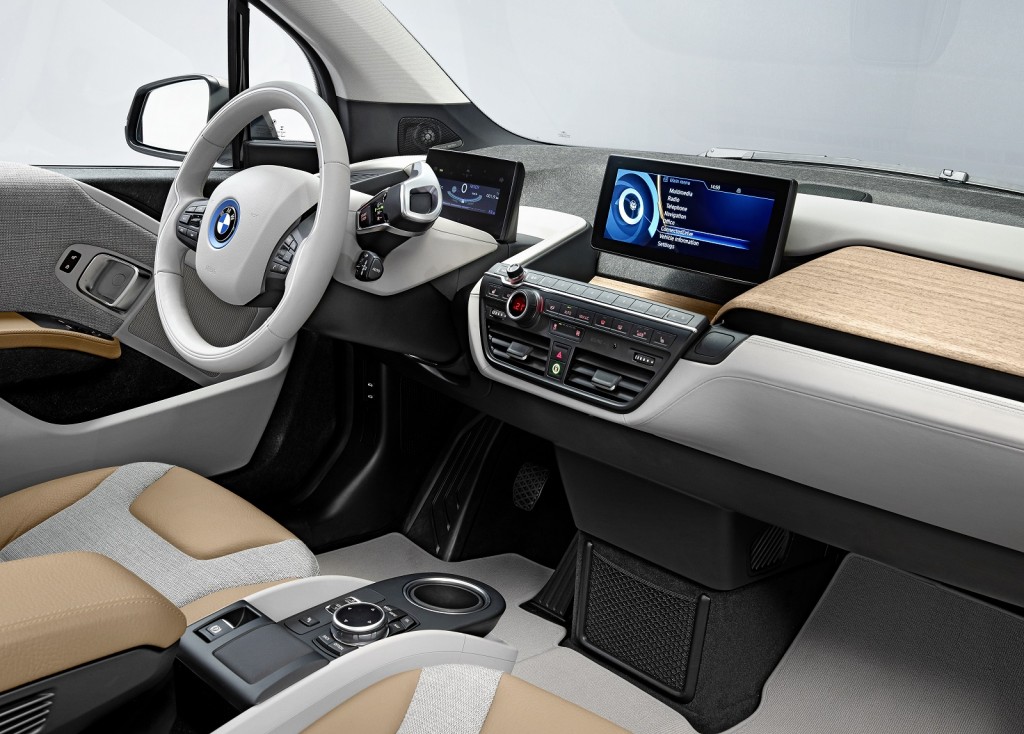This summer, buyers will have the option of two electric cars that on the surface, offer very similar attributes.
Both are from Germany, for a start. Each has a very similar price tag. Each offers four doors and a liftback-style luggage area.
Those cars are the 2014 BMW i3 and the 2014 Mercedes-Benz B-Class Electric Drive. And since we've driven both, we decided the two German rivals are ripe for comparison.
The numbers
That starts with what each car actually offers a buyer looking for a new electric car. In theory, there might not be much to separate the two cars here either.
BMW's i3 has an EPA-rated range of 81 miles, and boasts efficiency of 124 MPGe combined (138 MPGe city, 111 MPGe highway) from its 22 kWh lithium-ion battery pack.
The Mercedes touts a slightly larger pack, and is likely to offer lower overall efficiency, but the extra 6 kWh means Mercedes predicts a range of 85 miles.
There isn't a huge difference in performance, either. Officially, the i3 reaches the 60 mph benchmark from rest in 7.2 seconds. Just seven tenths of a second later, the B-Class will also clear that mark.
Unsurprisingly, that's the result of similar power outputs--130 kW (170 hp) for the lighter BMW, and 132 kW (177 hp) for the heftier Mercedes.
2014 Mercedes-Benz B-Class Electric Drive
The BMW's relatively low weight, just 2,635 lb, is the result of clever construction pioneered by BMW--the i3 is one of the world's first mass-market vehicles using carbon fiber reinforced plastic construction. Paired with aluminum subframes, the i3 is strong, yet light.
While Mercedes' offering is sure to be as strong as any other car wearing the three-pointed star, it certainly isn't light.
With conventional steel construction like that of the regular B-Class models sold in Europe, it tips the scales at over 3,900 lbs--600 lbs more than even Nissan's already portly Leaf.
The differences continue in the two cars' drivetrains. Mercedes' electric model uses a conventional front-motor, front-wheel drive setup--belying its regular combustion car roots. Interestingly, this is all supplied by Tesla Motors--so the Mercedes does have plenty of EV-market kudos.
In contrast, the i3 stores its electric motor at the rear, powering the rear wheels--like any other BMW until the front-drive 2-Series Active Tourer arrives.
If you opt for the i3's range-extended equivalent, the engine too is stored towards the rear of the car, under the luggage deck.

2014 BMW i3 Electric Car: Connectivity, Navigation Highlights
Driving them
The i3's electric-only design is apparent the moment you open the door--or the rear door, which hinges backwards for an open-sided space.
It has a cabin like no other BMW, and the interior is full of neat, eco-influenced touches. Recycled materials abound and various interior "worlds" are available--some offering a high-end loft apartment vibe.
We're not keen on some of the cabin materials--BMW's 'kenaf' renewable fiber material on parts of the dash and door trims looks a bit "unfinished", though we like the woven seat fabrics, naturally-tanned leathers and eucalyptus wood trim on some models.
The car's two flat-screen displays, seemingly floating above the dashboard, are also a neat touch--and add to the airy sense of space.

2014 Mercedes-Benz B-Class Electric Drive - First Drive, May 2014
No such visual interest in the B-Class, which features a standard B-Class interior (similar to that also found in Mercedes' CLA sedan). It's elegant and high-quality, but hardly groundbreaking.
It's luxurious though, as you'd hope for, from a Mercedes. And it's very spacious--B-Class owners get an extra seat over the i3's four. The conventional rear doors allow plenty of space for entry too, which do make the i3's "suicide" doors seem a bit gimmicky.
Both are good to drive, with easily-accessible performance and competent road manners.
There are some differences--the i3 has a slightly stiffer ride than the Mercedes, the Electric Drive's softer setup perhaps partly a result of its extra weight.
The i3 also loses grip fairly early in higher-speed cornering--its tiny tires are great for efficiency, but can only offer so much in the way of lateral grip. The Mercedes copes better at these speeds, but does lack the agility of the BMW around town.
Each car's electric manners are slightly different too, and this may be instrumental in making your choice.

2014 BMW i3 (German-market version), Amsterdam, Oct 2013
The B-Class is more conventional. We'd like stronger brake regeneration to bring it closer to the BMW's one-pedal abilities, but the car's "efficiency" and "sport" driving modes do what they say on the button. It's predictable, and some drivers will like that.
Verdict
There's little to choose between the BMW and the Mercedes on price. The i3 will set you back $42,275 in regular battery-electric format, and Mercedes lists the B-Class with a $41,450 base price.
Neither of those figures take into account any local incentives or rebates you might have access to, nor do they include the $7,500 federal tax credit, available to some buyers.
In other words, you can expect to get each car cheaper than the listed price--though BMW and Mercedes option prices will soon bring those numbers back up again...
EPA-rated range may be a deciding factor, though we'll have to wait and see what the Mercedes gets in official testing before any definitive verdict can be made to that effect.
For some, the B-Class's extra interior volume, more conventional looks and more predictable driving characteristics may clinch it. And while it's only available in ten states initially--those who've adopted California's emissions regulations--Mercedes plans to expand sales to all 50 states eventually.
For others, the i3's innovative layout, futuristic styling and better performance may appeal more--as may the option of a range-extended model, for those who just can't get used to an 80-odd mile range.
The bottom line, though, is that both are very good electric cars with plenty to recommend them. The real winner in this comparison is consumer choice...
_________________________________________













